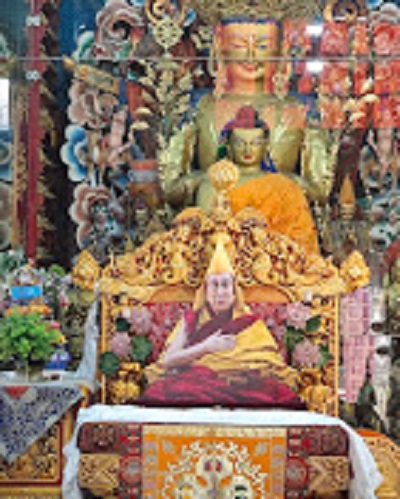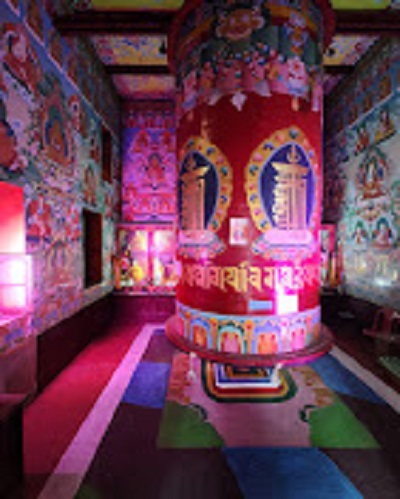Inside Area

The inside area of the Tibetan Temple in Bodh Gaya is a peaceful and spiritually vibrant space that beautifully reflects Tibetan Buddhist culture. As you enter, large golden prayer wheels line the path, inviting visitors to spin them while chanting the sacred mantra “Om Mani Padme Hum”, believed to bring peace and positive energy. The heart of the temple is the main prayer hall, which houses a majestic statue of Maitreya Buddha, the Buddha of the Future, symbolizing hope, compassion, and enlightenment. The statue is surrounded by offerings of butter lamps, flowers, and incense, creating a deeply spiritual ambiance. The walls are decorated with thangka paintings and detailed murals that depict important events from the life of Buddha and other Tibetan Buddhist deities. The ceiling is adorned with colorful designs, mandalas, and traditional Tibetan motifs. Monks are often seen chanting and meditating, and visitors are welcome to sit quietly and take in the calm, meditative environment. The architecture inside blends sacred art with cultural richness, making it not just a place of worship but also a center for preserving Tibetan heritage. It offers a serene escape and a deep spiritual experience for both pilgrims and travelers visiting Bodh Gaya.
Other Attractions
The Tibetan Temple in Bodh Gaya is not only a sacred place of worship but also surrounded by several attractions that add to its spiritual and cultural significance. One of the main highlights is the giant prayer wheel located just outside the temple. Made of brass and beautifully carved with the mantra “Om Mani Padme Hum”, it is believed that spinning this wheel brings peace, good fortune, and the blessings of Avalokiteshvara, the Bodhisattva of Compassion. The temple is surrounded by lush gardens and peaceful open spaces, making it an ideal place for meditation and quiet reflection. Colorful prayer flags flutter in the wind, symbolizing prayers being carried across the universe. There are also Tibetan stalls and shops nearby, offering spiritual items like prayer beads, incense sticks, singing bowls, and traditional handicrafts, which attract both pilgrims and tourists. During special occasions such as Losar (Tibetan New Year), the temple comes alive with traditional music, dances, and rituals, offering a rich cultural experience. The Tibetan Temple is also located near other international monasteries, making it part of a diverse spiritual landscape. These features make the temple not just a religious site but a vibrant center of Tibetan culture and spirituality in Bodh Gaya.

Distance From
Gaya Railway Station
The Tibetan Temple in Bodh Gaya is about 14 km from Gaya Railway Station

Gaya Airport
The Tibetan Temple in Bodh Gaya is about 9.4 km from Gaya Airport

Gaya Bus Stand
The Tibetan Temple in Bodh Gaya is approx 1.5 km from Bus Stand,

Our Review
The Tibetan Temple in Bodh Gaya is a peaceful and spiritually uplifting place that beautifully represents the essence of Tibetan Buddhism. From the moment we arrived, we were welcomed by the soothing sounds of chanting monks and the sight of colorful prayer flags fluttering in the breeze. The large golden prayer wheels, which visitors spin for blessings, added a unique and calming touch to the experience. Inside the temple, the statue of Maitreya Buddha is truly majestic and radiates a sense of peace and hope. The intricate wall paintings, thangka art, and detailed woodwork reflect the richness of Tibetan culture and devotion. The environment is clean, quiet, and perfect for meditation or simply sitting in silence. What impressed us most was the respectful behavior of the monks and the overall spiritual vibe of the place. Whether you are a devotee or a curious traveler, the Tibetan Temple offers a memorable and meaningful experience. It’s a must-visit site for anyone coming to Bodh Gaya, not just for its beauty, but for the inner peace it brings. Ask ChatGPT
